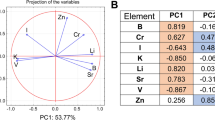Abstract
Data relating to trace-elements status in camels is scarce, from both a clinical and biochemical point of view. Clinical deficiency or toxicity has rarely been described in this species. However, there is a some evidence that camels are sensitive to trace element disorders in the same way as other ruminants. For example, copper deficiency in camels has been reported in East Africa. Normal plasma level is comparable to cattle (70–120 mg/100 mL). Camels appear to maintain zinc levels at a lower value than other domestic ruminants (<60μg/100 mL). Iron metabolism is more active in the liver than in the spleen. Data concerning manganese levels are possibly unreliable. Some cases of selenium deficiency (white muscle disease) have been reported. No data are available for cobalt status in camels. Finally, camels appear to be more sensitive to iodine deficiency than the other domestic ruminants.
Similar content being viewed by others
References
G. Saint-Martin, Bibliography on camel, ed. Maisons-Alfort, EMVT/CIRAD (1990).
W. Mertz, Science, 213; 1332–1338 (1981).
G. Tartour, Trop. Anim. Hlth. Prod.,7, 87–94 (1975).
B. Faye and C. Grillet,Rev. Elev. Med. Vet. Pays Trop.,37(1), 42–60 (1984).
B. Faye, M. Kamil and M. Labonne,Rev. Elev. Med. Vet. Trop.,43(3), 365–373 (1990).
B. Faye and J. L. Tisserand,Options Méditerranéennes. Séries Séminaires no. 2, 61–65 (1989).
T. Rutagwenda, H. J. Lechner-Doll, W. Schwartz, W. Schultka, and W. von Engelhart,Anim. Feed Sci. Techn.,31, 179–192 (1990).
G. Tartour, Study of the role of certain trace-elements in relation to the health of livestock in the Sudan, PhD Thesis. Univ. of London (1966).
B. Faye, C. Grillet, and A. Tessema,Rev. Elev. Med. Vet. Pays Trop.,39(2), 227–237 (1986).
T. W. Schillhorn Van Veen, and I. K. Loeffler,Trop. Anim. Hlth. Prod. 22, 197–205 (1990).
B. Faye, C. Grillet, A. Tessema, and M. Kamil,Trop. Anim. Hlth. Prod. 123, 172–180 (1991).
B. Faye, and C. Mulato,Rev. Elev. Med. Vet. Pays Trop. 44(3), 325–334 (1991).
B. Faye, G. Saint-Martin, R. Cherrier, and AH. Ruffa,Comp. Biochem. Physiol.,102A(2), 409–416 (1992a).
B. Faye, G. Saint-Martin, R. Cherrier, and AH. Ruffa,Comp. Biochem. Physiol. 102A(1), 417–424 (1992b).
B. Faye, M. Ratovonanahary, and R. Cherrier,Rev. Elev. Med. Vet. Pays Trop.,46(3), (1993).
A. C. Palmer, W. F. Blakemore, B. O'Sullivan, D. G. Ashton, and W. A. Scott,Vet. Rec. 107, 10–11 (1980).
O. M. Abdalla, I. A. Wasfi, and F. A. Gadir,Comp. Biochem. Physiol. 90A(2), 237–239 (1988).
M. M. El Tohamy, A. Salama, and A. E. M. Youssef,Beitrãge für Trop. Landwitschaft und Vet. Med. 24(4), 425–430 (1986).
G. Tartour and O. F. Idris,Acta Vet. (Brno),39, 397–403 (1970).
H. H. Mohamed, A. H. Mohamed, and A. Locatteli,Rev. Elev. Med. Vet. Pays Trop. 37(3), 313–317 (1984).
H. Abu Damir, G. Tartour, and S. E. I. Adam,Trop. Anim. Hlth. Prod. 15, 15–16 (1983).
G. Tartour,Studan J. Vet. Sci. Anim. Husb. 10(1), 14–20 (1969).
H. Khalifa, M. T. Foad, Y. L. Awad, and M. E. Gregory,Microchem. J. 18, 536–542 (1973).
J. Wensvoort,Proc. 1st Int. Camel Conf. Dubaï, U.A.E., 319–322 (1992).
A. G. Abdelrahim,Wld. Rev. Anim. Prod. 18(1), 9–12, (1983).
K. El Kasmi, Constribution à l'étude des protéines sériques et de certains minéraux chez le dromadaire: influence de l'âge et du sexe. Mémoire de ler Cycle. Univ. Hassan II, Rabat, MAROC, 46 pp. (1989).
Y. L. Awad and F. Berschneider,Egypt. J. Vet. Sci. 14(1), 31–35 (1977).
E. J. Underwood, Trace-elements in human and animal nutrition, 4th ed., Academic Press, NY (1977).
W. N. Sawaya, J. K. Khalil, A. Al-Shalhat, and H. Al-Mohamed,J. Food Sci. 49(3), 744–747 (1984).
M. Z. Barakat and M. Abdel-Fattah,Zbl. Vet. Med. A 18, 174–178 (1971).
A. K. Ghosal, P. K. Dwaraknath, and P. R. Jatkar,Indian J. Anim. 46(8), 449 (1976).
M. Lamand,Rec. Med. Vet. 163(11), 1071–1082 (1987).
R. Finlayson, I. F. Keymer, and V. J. A. Manton,J. Comp. Path. 81, 71–77. (1971).
L. R. McDowell,World Rev. Anim. Prod. 18(4), 19–32 (1987).
C. L. Zhang, J. L. Su, and Y. O. Feng,Chin. J. Vet. Med. 12(9), 17–18 (1986).
A. Hamliri, K. Khallayoune, D. W. Johnson, and M. Kessabi,Vet. Res. Commun. 14, 27–30 (1993).
R. Burenbayar, Supply of trace-elements for female camels in Mongolia. VIth Int.Trace-elements symposium, Leipzig, vol. 2 (1989).
R. A. Decker, J. C. Hruska, and A. M. McDerrid,JAVMA 175(9), 968–969 (1979).
M. H. Tageldin, S. El Salvi, and S. G. Ibrahim,Rev. Elev. Med. Vet. Pays Trop. 38(4), 394–397 (1985).
G. Aumont, M. Lamand, and J. C. Tressol,Reprod. Nutr. Develop. 29, 113–125 (1989).
M. F. Abdel-Wahab, M. S. Abdo, Y. M. Megahed, and S. A. Mougy,Endokrinologie 63(1), 116–121 (1974).
G. Aumont,Ann. Rech. Vet. 13, 205–210 (1982).
M. F. Abdel-Wahab, and A. M. Osman,Endokrinologie 58(2), 198–208 (1971).
Z. Etzion, Z. Alfassi, N. Levi, and R. Yagil,Trace Elem. Res. 12, 411–418 (1987).
M. H. Karram, A. A. Mottelib, T. S. Nafie, and A. S. Sayed,Assiut Vet. Med. J. 21(41), 165–176 (1989).
R. C. Bhattarcharjee, and S. Banerjee,J. Sci. Industr. Res. 21C, 106–107 (1962).
M. Bengoumi, Biochimie clinique du dromadaire et mécanismes de son adaptation à la déshydratation. Thesis Doct. Sciences Agronomiques I.A.V. Hassan II Rabat, Maroc, 184 pp. (1992).
I. A. Moty, A. Mulla, and S. A. Zoafer,Sudan Agric. J. 3, 146–151 (1968).
A. A. Whabi, S. E. Abdel Godir, A. A. Neimat, and Y. O. F. Idris. Plasma electrolytes and minerals of normal camels in the Sudan, inCamels and Camelids, W. R. Cockrill, ed., Uppsala, Sweden, pp. 431–437, (1979).
B. Faye and C. Grillet,Rev. Elev. Med. Vet. Pay. Trop. 37(1), pp. 42–60 (1986).



